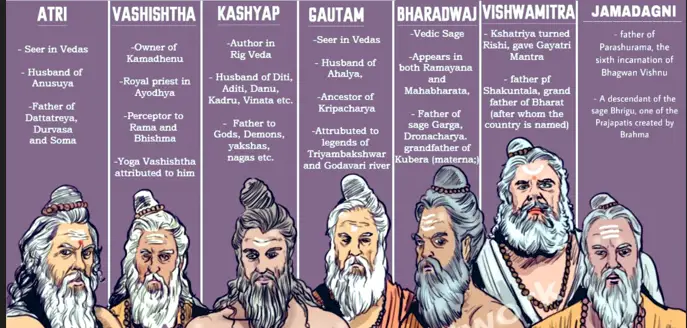Here’s a detailed explanation of the different types of Gotras:
1. Vedic Gotras
- Origin: These Gotras are rooted in ancient Hindu scriptures, specifically the Vedas.
- Significance: They are named after Rishis (sages) who are considered the founders or spiritual ancestors of the Gotras.
- Examples: Kashyapa, Atri, Bharadwaja, Gautama, Vashishtha, Jamadagni, and others.
- Usage: Families belonging to Vedic Gotras trace their lineage to these ancient sages, and the Gotra plays a crucial role in rituals, ceremonies, and maintaining religious practices.
2. Regional Gotras
- Characteristics: These Gotras are specific to regions or states within India and have a distinct identity based on the local culture, customs, and communities.
- Northern India Gotras: Focus on regions like Uttar Pradesh, Punjab, Rajasthan, etc. Gotras in these regions are influenced by local customs and ancient traditions.
- Example: Gotras such as Chauhan, Rathore, Rathore Rajput, etc., which are prominent in Rajasthan.
- Southern India Gotras: Gotras are categorized based on states like Tamil Nadu, Kerala, Andhra Pradesh, and Karnataka.
- Example: Gotras such as Iyengar, Iyer, Nair, Velanadu, etc., are more specific to South Indian traditions.
- Western India Gotras: Maharashtra, Gujarat, and Madhya Pradesh are known for distinct Gotras like Pawar, Deshmukh, Gohil, etc.
- Eastern India Gotras: Gotras prevalent in Bengal, Odisha, Assam, etc.
- Example: Gotras such as Bhattacharya, Goswami, Choudhury, etc.
3. Community-Specific Gotras
- Brahmin Gotras: These Gotras are specific to Brahmin communities, who are traditionally priests or scholars.
- Example: Shukla, Dubey, Tripathi, etc.
- Rajput Gotras: Gotras found within Rajput communities, often associated with clan identities.
- Example: Rathore, Sisodia, Rathore Rajput, Chauhan, etc.
- Jat Gotras: Gotras specific to the Jat community, which is primarily an agricultural community in northern India.
- Example: Sandhu, Singh, Malik, etc.
- Kshatriya Gotras: Belong to the warrior or ruling class, with distinct Gotras reflecting historical affiliations to kingdoms or regions.
- Example: Solanki, Sisodia, Rana, etc.
- Other Communities: Gotras in Dalit, OBC, and tribal communities, which are more region-specific and tied to social structures and traditions.
- Example: Panwar, Saini, Bhardwaj, etc.
4. Mixed and Uncommon Gotras
- Characteristics: These Gotras may not follow the traditional patterns or are less commonly known due to the unique blending of different regional or community influences.
- Example: Gotras like Rajgaria, Jangi, or other newly evolved or uncommon Gotras that don’t strictly adhere to older traditions.
Summary
The types of Gotras represent a broad spectrum of lineages that include ancient Vedic origins, regional identities, community-specific affiliations, and unique, less commonly known variations. Each type serves to preserve heritage, family identity, and religious or social practices within diverse Indian communities.



